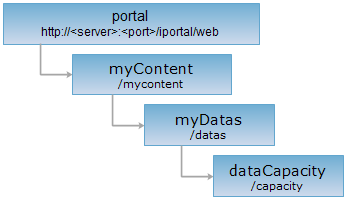<mydatas_uri>/capacity[.<format>]
With dataCapacity resource, users could view current data capacity status.
Supported Methods:
Supported output formats: RJSON, JSON, HTML and XML.

Execute the HTTP request on the following URI, where supermapiportal is the server name, with rjson being the output format.
http://supermapiportal:8090/iportal/web/mycontent/datas/capacity.rjson
Get user's data capacity information.
Execute GET request on dataCapacity resource, and return current user's data capacity information. It is composed of:
| Field | Type | Description |
| maxCapacity |
long |
Maximum capacity. Each user has 2G capacity by default. Administrator could change the maximum according to Data Management Page. |
| usedCapacity |
long |
Capacity used, in Bytes. |
The returned rjson format representation after executing the GET request on the dataCapacity resource http://localhost:8090/iportal/web/mycontent/datas/capacity.rjson is as follows:
{
"maxCapacity": 2147483648,
"usedCapacity": 8315645
}
Asks for the response identical to the one that would correspond to a GET request, but without the response body. This is useful for retrieving meta-information written in response headers, without having to transport the entire content. The meta-information includes the media-type, content-encoding, transfer-encoding, content-length, etc.
HEAD request can be used to check if the dataCapacity resource exists, or if the dataCapacity resource can be accessed by clients. It can also determine if the dataCapacity resource supports an output format <format> if performed on a URI with .<format> included.